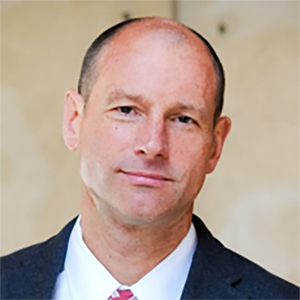Ed equity takes the right mix of litigation, research, policy, and coalition-building
Prof. William Koski spent his sabbatical from Stanford Law School this semester at CPRL. An accomplished clinical teacher and litigator, Prof. Koski is the founder and director of Stanford Law School’s Youth and Education Law Project (YELP). He has taught multidisciplinary graduate seminars and courses in educational law and policy; represented hundreds of children, youth, and families in special education, student discipline, and other educational rights matters; and written on educational accountability, equity, and adequacy; the politics of educational policy reform; teacher employment policies; and judicial decision-making in educational policy reform litigation.
We recently sat down with Prof. Koski to get his insights on how to make and sustain systems change in public education and how his work with CPRL supports that.

You chose to spend your sabbatical at CPRL. Why?
I first learned about CPRL in about 2014. I had been a clinical law professor for more than 15 years and, although my students were learning to be lawyers and my youth clients were achieving some success in their legal matters, I was looking for ways to improve my teaching and practice and move beyond a traditional litigation and legal services model. My clinic, the Youth and Education Law Project, had been doing direct services work for children with disabilities and their families and for young people getting caught up in the school-to-prison pipeline. We did school reform litigation and legislative advocacy, but we were not as effective at tackling the underlying systemic problems that children and communities faced, specifically low-income communities of color. The problems our clients and their communities faced were complex and required complex, multi-disciplinary solutions. We were not generating a lot of new ideas about the way forward.
That was when Jim Liebman, CPRL’s founder, reached out to talk about CPRL. I had long admired Jim’s work in pursuing educational equity and what I have come to see as CPRL’s “secret sauce:” bringing together interdisciplinary groups of students to solve real-world problems while learning to practice across disciplinary and professional boundaries. Professionals, especially lawyers, need to learn to play in the sandbox with other professionals and the best way to learn is through hands-on experience.
Why is a multidisciplinary approach so important for solving some of education’s deeply entrenched challenges?
When we are working as a group of professionals who each bring their own disciplinary lens to a problem, it broadens the conversation and the solutions. Everything looks like a nail when you're a hammer. Everything looks like a legal problem when you’re a lawyer – you see a problem and might be inclined to sue. Someone with business expertise might come up with a market-based solution. An education professional brings a depth of knowledge about the on-the-ground challenges within and across school buildings. Bringing all of that into the mix is important, particularly when you’re trying to solve problems, like the longstanding, deep-seated inequities we see in public education, by creating structural change for kids for whom systems just have not worked.
Litigation, strategic research, policy, coalition-building work – you need to be open to all of them and put more than one in play. You need to know when to pull which levers. This requires a collaborative approach, one that understands the change process and where there might be resistance to change, one that channels the collaborative process as an opportunity for learning and growth. This is how I see the team at CPRL, now under the leadership of Liz Chu, facilitating real systems transformation.

When is litigation the right tool for addressing inequities, and when does it fall short?
In my clinic, we have historically done the important and unglamorous work of advocating for the educational rights of individual children. We go to individualized education plan meetings to advocate for appropriate services for children with disabilities. We represent youth in expulsion hearings to try to keep them in school. That work is important and needs to be done. But sometimes this case-by-case approach doesn’t address the underlying, systemic problems in schools and school systems – such as a special education program that routinely segregates children with behavioral problems (often children of color) in self-contained classrooms or a system that frequently uses suspensions and law enforcement to deal with even modest behavioral issues that may be the product of trauma.
There are occasions, particularly when there isn’t an impetus for internal change, when litigation is the right tool for destabilizing the status quo. So as a clinic, sometimes we turn to school reform litigation. By catalyzing change from the outside, a lawsuit can help disentrench political interests and ensure that traditionally marginalized communities have a seat at the table. It gives us a disciplined way to get at some of the structural changes that lead to educational equity so you're not just throwing new initiatives at the problem hoping they'll stick. Litigation could close down self-contained classrooms under the principle of “least restrictive environment,” or ensure that administrators are providing due process protections so that youth are not arbitrarily disciplined and excluded from school.
We’ve litigated those cases. But, what we’ve learned is that litigation also has its limits. Including children with disabilities in a general education classroom as the result of a lawsuit doesn’t guarantee them appropriate and effective services. Judicial mandates alone won’t change classroom practices. But they could create a space for collaborative problem-solving and long-term organizational improvement.
That’s where the systems and organizational change strategies that CPRL employs can be most effective. How can we collaborate with policy-makers, administrators, and educators to bring about equity-minded reform, even when it’s difficult and resource-intensive? CPRL’s Evolutionary Learning approach brings community stakeholders and diverse professional lenses that can transform classrooms into truly inclusive, safe, supportive, and enriching academic settings for children.
You are leading CPRL students in a complex project this semester. How are you and your students bringing some of this approach to life in that work?
We are working with an organization to develop ideas for improving how a state education agency and one large school district can better monitor and improve service delivery for children with disabilities in the charter schools. This state agency and district has been under a judicial order to improve their monitoring and oversight of the charter schools, but if that order is lifted, there is concern that the charter schools will not provide equitable access and appropriate services to children with disabilities. The subject matter is very complex and not well understood or researched. This project allows students to think about how systems can be better designed to improve learning experiences and outcomes for students with disabilities. They see that this work requires an Evolutionary Learning approach, an approach that uses continuous improvement monitoring as central to learning and growth.
This project really demonstrates how litigation is not the end-all be-all, but a helpful tool when used in conjunction with community organizations, research, legal advocacy work, and other opportunities. In special education law and accountability, there is a mentality that compliance matters. We are trying to change that and move toward a more outcomes- and performance-oriented learning model that emphasizes continuous improvement.
Based on your experience leading the law clinic at Stanford and at CPRL, what do you see is the future of professional education?
Maybe I’m an unreconstructed clinical educator, but I believe that professional education happens outside the classroom in the context of real-world problems. The classroom is terrific for teaching theory, doctrine, reasoning, and how to think like a lawyer. But it’s not the best place to learn how to plan a project, to attack a new situation that is unstructured, where emotions may be running high and the facts are not always known. That type of problem-solving is the hallmark of professional work. Clinical work helps build the capacities that are essential for any profession: leadership, team building, team work, collaboration, emotional intelligence, collecting and creating information, managerial skills. The students I’m working with at CPRL are also building an understanding of organizational change, of the importance of taking a multi-pronged interdisciplinary approach to solving problems and how to create democratic organizations and center equity. For a lawyer, those abilities are as important as knowing legal doctrine.